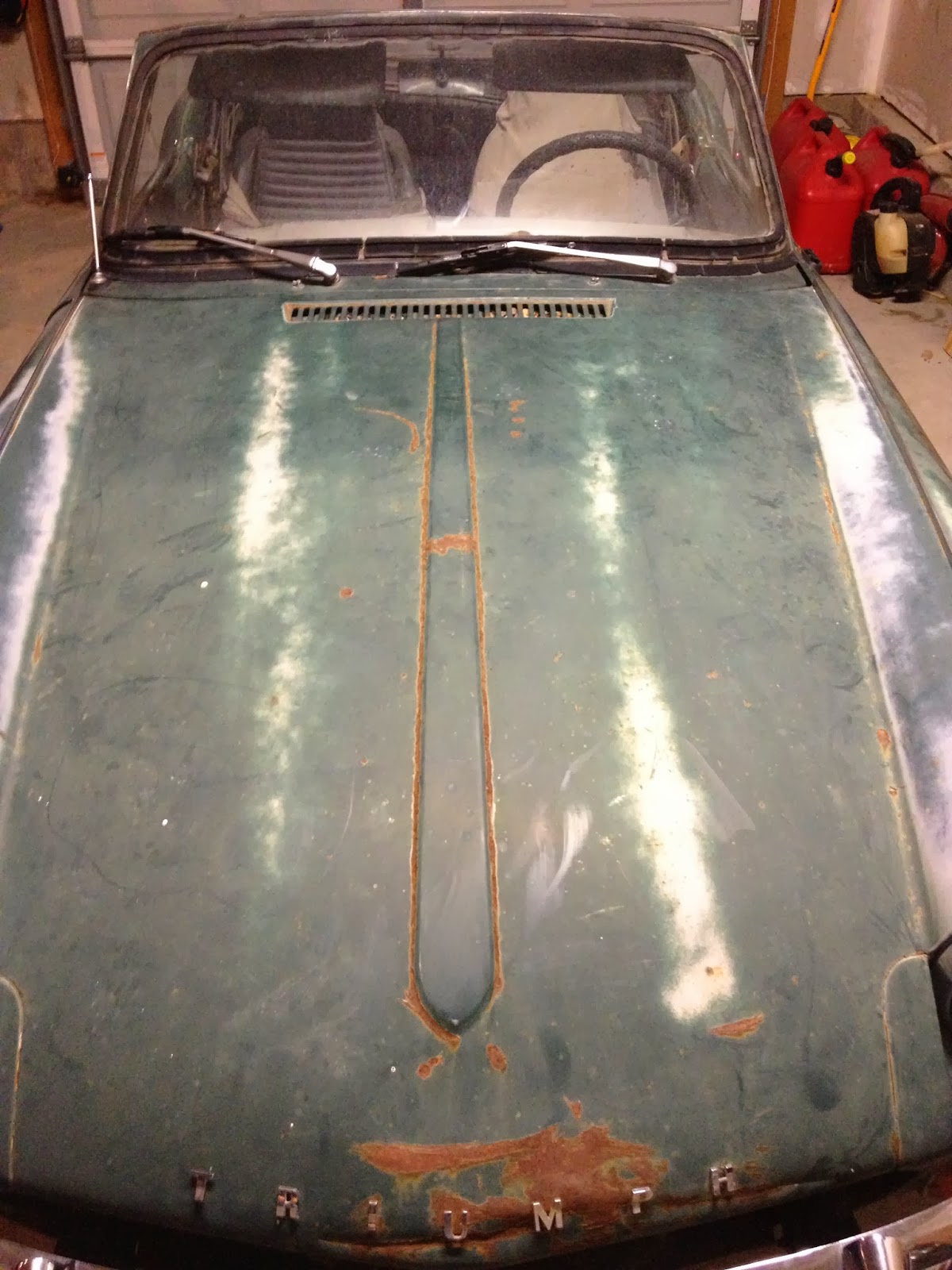Here is another view from the top from the driver's side. Note the ballast resistor located just below the coil. Prior to Triumph using a ballast wire in the ignition wiring, a separate ballast resistor was used to cut the voltage from 12v to 6v while the engine was running. If a 6v coil is continually fed 12v, it will overheat and have a shortened life.
Upon looking closer at the ballast resistor, I noticed that the positive (+) side of the coil was attached to the distributor. In my 1972 Spitfire 1500, the negative (-) side of the coil is attached. That immediately made me wonder if this car is set up with a positive (+) ground? The initial indications such as how the coil was attached were that it was.
Another indication is that the positive (red) battery cable was attached to the block, while the negative cable (black) was attached to the starter solenoid.
However, taking a closer look at a photo I took when I first got the car home, look at how the battery is attached. The negative post is attached to the red battery cable/engine ground (-), while the positive post is attached to the black battery cable (+) and solenoid. Also, there were wires with inline fuses routed to under the dash, probably for an aftermarket stereo. So, it appears that at some point the system was converted to a negative (-) ground system, but the wiring to the distributor does not suggest that it was done correctly. Here's a nice article on converting a car to negative ground, which I will follow to ensure that everything is connected correctly: http://www.vtr.org/maintain/negative-ground.shtml With these questionable observations, it immediately led to investigating the overall wiring situation on the car.
The 1969 Spitfire MK3 uses a generator along with an external voltage regulator, instead of an alternator (which is internally regulated). Looking at the connections on the voltage regulator, they were for the most part intact other than the connectors being oxidized. Each connector was removed and both the connector and posts were cleaned. Dielectric grease was used on each when replaced. However, the wire missing on the second-from-the-left post is attached to the starter solenoid, and part of the insulation on that wire had melted, likely from a short in the system. That wire will need to be repaired. Also, the wire on the far left is a junction of two wires, and one of the wires broke easily when moved. This led to taking a closer look at all of the wires and connectors in the harness to evaluate their condition.
One wire leading from the starter solenoid was home-built and led from the (+) feed on the solenoid to a relay. However, next to the solenoid was the wire connector that had been disconnected. The previous owner had not taken the time to see what the problem was an instead just fabricated and routed a new wire in its place. That's a bad omen, as I soon was about to find out.
Here's where the other end of the home-built wire led to. You can see the disconnected wire (purple) in the bottom right.
Finding more and more evidence of wiring in need of repair, each of the wires/connectors on the firewall were removed until the entire harness was free. Below is a spade connector with three wires feeding it that was mounted on the firewall with no other connector leading into it, as if a relay was removed and never replaced.
After disconnecting all of the wires and feeding it through the openings under the brake and clutch master cylinders, here's what now lies in front of me. I cleaned each wire with degreaser so that its original Lucas color could be identified. This will help with troubleshooting as I trace each wire to where it is supposed to go and verify the integrity of each connection.
Here is a close-up of the connectors to the fuse block. Some of the connections here are very questionable and will be repaired.
After removing the wiring harness, it was a good time to remove everything off of the bulkhead so that the surface rust can be addresses. It will be treated with a rust converter/rust inhibitor and primed/painted.
Here is another view of the colorful Lucas wiring harness. Each wire will be looked at individually.
As it typical on most older Triumphs, the battery box has been eaten through with rust/battery acid and will need to be replaced.
Here is the braided ground connector between the body tub and the engine. It's questionable how good the ground actually was since it was covered with rust.
Here is another view of the bulkhead with the battery, starter solenoid, heater valve, coil, brake master cylinder, and clutch master cylinder removed.
With the wiring harness removed from the bulkhead, access was going to be needed under the dash to be able to correctly trace each wire. That meant that the dash had to be removed. Below is the after photo. All wiring connections were kept in place for the time being.
A close up of the tachometer & speedometer backsides.
Another view of the inside of the car. This picture is remarkably similar to the current state of my 1973 Spitfire 1500!
A final picture of the Lucas colored wiring. Notice the melted condition of the insulated brown wires in the middle of the photo. That same issue is on at least some portion of the majority of wires, typically at where they emerged from the bulkhead. I will have to check the continuity of each wire to determine whether it needs to be repaired or replaced. Wiring fun!







































































